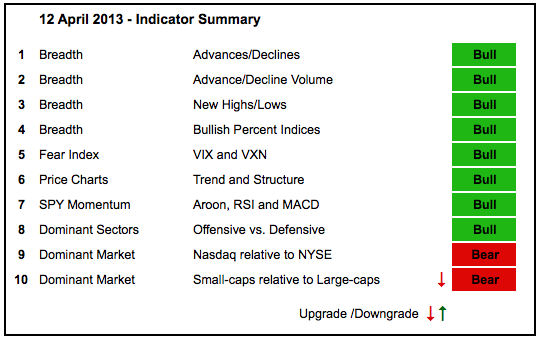The indicator summary remains firmly bullish with eight of ten indicators favoring the bulls. The two bearish indicators reflect relative weakness in the Nasdaq and small-caps, which indicates that the tolerance for risk is fading somewhat. In addition, note that the Nasdaq AD Line is underperforming the NYSE AD Line. Nevertheless, there are few, if any, signs of weakness on the actual price charts. Three of the five major index ETFs hit new highs for 2013 this week. Momentum is bullish and volatility is low. Note, however, that the six month cycle turns bearish in a couple of weeks and stocks are ripe for some sort of corrective period.
- AD Lines: Bullish. The Nasdaq AD Line has started to seriously underperform the NYSE AD Line. The NYSE AD Line hit a new high this week, but the Nasdaq AD Line remains well below its March highs. Both, however, are still in uptrends overall.
- AD Volume Lines: Bullish. The Nasdaq and NYSE AD Volume Lines moved to new highs this week and remain in clear uptrends.
- Net New Highs: Bullish. Net New Highs remain strong and the cumulative Net New Highs lines moved to new highs.
- Bullish Percent Indices: Bullish. All nine sector Bullish Percent Indices are above 50%. The finance, healthcare and utilities BPIs are above 90%.
- VIX/VXN: Bullish. The S&P 500 Volatility Index ($VIX) and the Nasdaq 100 Volatility Index ($VXN) are in clear downtrends and below 15%.
- Trend-Structure: Bullish. DIA, QQQ and SPY hit new highs for the year and are in uptrends. IWM and MDY hit resistance from their March highs, but are in uptrends as well.
- SPY Momentum: Bullish. RSI has been in the bull zone (40-80) since early December. MACD(5,35,5) has been positive since late November and the Aroon Oscillator has been in bull mode since early December.
- Offensive Sector Performance: Bullish. The defensive sectors may be leading and showing relative strength, but the offensive sectors are by no means weak. XLY and XLF hit 52-wee highs this week.
- Nasdaq Performance: Bearish. The $COMPQ:$NYA ratio flattened in 2013, but has yet to turn up. The Nasdaq remains relatively weak.
- Small-cap Performance: Bearish. The $RUT:$OEX ratio plunged in early April and broke its February lows. Small-caps are starting to show relative weakness.
- Breadth Charts (here) and Inter-market charts (here) have been updated.
This commentary and charts-of-interest are designed to stimulate thinking. This analysis is
not a recommendation to buy, sell, hold or sell short any security (stock ETF or otherwise).
We all need to think for ourselves when it comes to trading our own accounts. First, it is
the only way to really learn. Second, we are the only ones responsible for our decisions.
Think of these charts as food for further analysis. Before making a trade, it is important
to have a plan. Plan the trade and trade the plan. Among other things, this includes setting
a trigger level, a target area and a stop-loss level. It is also important to plan for three
possible price movements: advance, decline or sideways. Have a plan for all three scenarios
BEFORE making the trade. Consider possible holding times. And finally, look at overall market
conditions and sector/industry performance.

About the author:
Arthur Hill, CMT, is the Chief Technical Strategist at TrendInvestorPro.com. Focusing predominantly on US equities and ETFs, his systematic approach of identifying trend, finding signals within the trend, and setting key price levels has made him an esteemed market technician. Arthur has written articles for numerous financial publications including Barrons and Stocks & Commodities Magazine. In addition to his Chartered Market Technician (CMT) designation, he holds an MBA from the Cass Business School at City University in London.
Learn More






